Emergence of a Landau Level Structure in Dark Optical Lattices

We introduce an optical flux lattice scheme where atoms occupy a dark state—an internal state decoupled from light—strongly reducing heating from photon scattering. In this regime, atoms exhibit a band structure strikingly similar to Landau levels of electrons in a magnetic field: nearly flat, equally spaced topological bands with Chern number one. This continuum-like behavior contrasts with discrete tight-binding models of previously studied optical lattices. Fermionic systems should exhibit incompressible bulk phases with chiral edge currents, while Bose-Einstein condensate feature vortex lattices. This protocol offers a practical route toward simulating quantum Hall physics with ultracold atoms.
Nascimbene, S. & Dalibard, J., Emergence of a Landau Level Structure in Dark Optical Lattices, Phys. Rev. Lett. 135, 153402 (2025)
Realizing the entanglement Hamiltonian of a topological quantum Hall system

Spatial entanglement in a many-body system is encoded in the properties of its reduced density matrix upon bipartition, or equivalently its entanglement Hamiltonian. While direct access to the entanglement Hamiltonian remains challenging, we realize it here as a genuine Hamiltonian governing the dynamics of an auxiliary system, making entanglement properties easily accessible. We apply this protocol to a topological quantum Hall system, and show that the entanglement Hamiltonian mimics a protected edge mode, in agreement with the Li-Haldane conjecture (link to data).
Redon, Q., Liu, Q., Bouhiron, J.-B., Mittal, N., Fabre, A., Lopes, R., & Nascimbene, S., Realizing the entanglement Hamiltonian of a topological quantum Hall system, Nature Commun. 15, 10086 (2024)
We have also performed a theoretical study of the extension of the entanglement Hamiltonian simulation to fractional quantum Hall states (in collaboration with A. Nardin, M. Rizzi and L. Mazza).
A. Nardin, R. Lopes, M. Rizzi, L. Mazza, & S. Nascimbene, Bisognano-Wichmann Hamiltonian for the entanglement spectroscopy of fractional quantum Hall states, Phys. Rev. B 111, 115162 (2025)
Realization of an atomic quantum Hall system in four dimensions
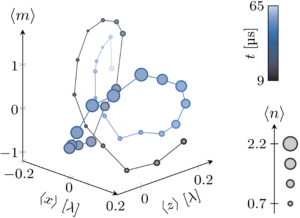
We engineered an atomic quantum Hall system evolving in 4D, by coupling with light fields two spatial dimensions and two synthetic ones encoded in the electronic spin J=8 of dysprosium atoms. We measured the characteristic properties of a 4D quantum Hall system, namely the quantization of its electromagnetic non-linear response by a second Chern number, and the special nature of its 3D hyperedge modes, which combine ballistic motion along one orientation and insulating behaviour in the two remaining directions. We also probed low-lying excitations, revealing non-planar cyclotron orbits in contrast with their circular equivalents in D≤3. Our findings pave the way to the exploration of interacting quantum Hall systems in 4D, from the investigation of strongly-correlated liquids to the simulation of high-energy models in link with quantum gravity and Yang-Mills field theory (link to data).
Bouhiron, J.-B., Fabre, A., Liu, Q., Redon, Q., Mittal, N., Satoor, T., Lopes, R., & Nascimbene, S. (2024). Realization of an atomic quantum Hall system in four dimensions. Science 384, 223–227 (2024)
Laughlin’s topological charge pump in an atomic Hall cylinder
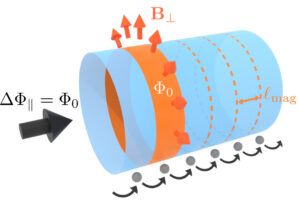
The quantum Hall effect occurring in two-dimensional electron gases was first explained by Laughlin, who envisioned a thought experiment that laid the groundwork for our understanding of topological quantum matter. His proposal is based on a quantum Hall cylinder periodically driven by an axial magnetic field, resulting in the quantized motion of electrons. We realized this milestone experiment with an ultracold gas of dysprosium atoms, the cyclic dimension being encoded in the electronic spin and the axial field controlled by the phases of laser-induced spin-orbit couplings. Our experiment provides a straightforward manifestation of the non-trivial topology of quantum Hall insulators, and could be generalized to strongly-correlated topological systems.
Fabre, A., Bouhiron, J.-B., Satoor, T., Lopes, R., & Nascimbene, S., Laughlin’s Topological Charge Pump in an Atomic Hall Cylinder,Phys. Rev. Lett., 128, 173202 (2022).
Simulating two-dimensional dynamics within a large-size atomic spin

Encoding a dimension in the internal degree of freedom of an atom provides an interesting tool for quantum simulation, facilitating the realization of artificial gauge fields. We propose an extension of the synthetic dimension toolbox, making it possible to encode two dimensions within a large atomic spin. The protocol combines first- and second-order spin couplings, such that the spin projection m and the remainder r = m (mod 3) of its Euclidian division by 3 act as orthogonal coordinates on a synthetic cylinder. It is suited for an implementation with lanthanide atoms, which feature a large electronic spin and narrow optical transitions for applying the required spin couplings. This method is useful for simulating geometries with periodic boundary conditions, and engineering various types of topological systems evolving in high dimensions.
Fabre, A., Bouhiron, J.-B., Satoor, T., Lopes, R., & Nascimbene, S., Simulating two-dimensional dynamics within a large-size atomic spin, Phys. Rev. A 105, 013301 (2022).
Partitioning dysprosium’s electronic spin to reveal entanglement in non-classical states

A large quantum spin J can be viewed as a collection of 2J elementary quantum bits (qubits). We studied entanglement between subsystems of the spin J by extracting pairs of qubits via the interaction with light. Our experiments reveal the link between non-classical spin correlations and the occurrence of entanglement between the underlying qubits. We also interpret spontaneous emission as a random qubit loss, inducing decoherence of quantum superpositions.
Satoor, T., Fabre, A., Bouhiron, J.-B., Evrard, A., Lopes, R., & Nascimbene, S., Partitioning dysprosium’s electronic spin to reveal entanglement in nonclassical states, Phys. Rev. Research 3, 043001 (2021).
Probing chiral edge dynamics and bulk topology of a synthetic Hall system
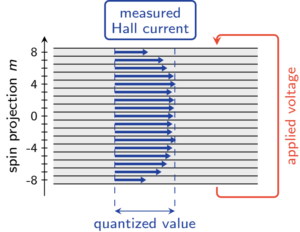
We studied the dynamics of dysprosium atoms manipulated by lasers, demonstrating a behavior analogous to electrons subjected to a magnetic field. We used two-photon transitions to couple the atomic motion and the internal spin state, which plays the role of a `synthetic’ dimension. As expected in Hall systems, we found a freezing of motion in the system bulk, and a chiral motion on the edges. We also measured a quantized transverse response, corresponding to a non-trivial topological property. This setting will be the frame for future studies of topological phases in interacting atomic systems.
Chalopin, T., Satoor, T., Evrard, A., Makhalov, V., Dalibard, J., Lopes, R., & Nascimbene, S., Probing chiral edge dynamics and bulk topology of a synthetic Hall system, Nature Phys. 16, 1017 (2020).
Probing quantum criticality and symmetry breaking at the microscopic level
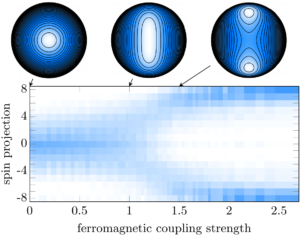
We studied experimentally the Lipkin-Meshkov-Glick model of interacting quantum spins, which exhibits a ferromagnetic phase transition in the thermodynamic limit. We used Dysprosium atoms of electronic spin J = 8, subjected to a quadratic Zeeman light shift, to simulate 2J = 16 interacting spins 1/2. We probed the system microscopically using single magnetic sublevel resolution, giving access to the spin projection parity, which is the collective observable characterizing the underlying Z2 symmetry. We measured the thermodynamic properties and dynamical response of the system, and studied the quantum critical behavior around the transition point. In the ferromagnetic phase, we achieved coherent tunneling between symmetry-broken states, and tested the link between symmetry breaking and the appearance of a finite order parameter (link to data).
Makhalov, V., Satoor, T., Evrard, A., Chalopin, T., Lopes, R., & Nascimbene, S., Probing Quantum Criticality and Symmetry Breaking at the Microscopic Level, Phys. Rev. Lett. 123, 120601 (2019).
Sensing magnetic fields with non-gaussian quantum fluctuations
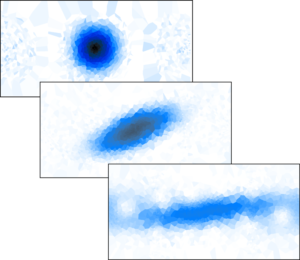
The precision of a quantum sensor can overcome its classical counterpart when its constituants are entangled. In gaussian squeezed states, quantum correlations lead to a reduction of the quantum projection noise below the shot noise limit. However, the most sensitive states involve complex non-gaussian quantum fluctuations, making the required measurement protocol challenging. Here we measured the sensitivity of non-classical states of the electronic spin J=8 of dysprosium atoms, created using light-induced non-linear spin coupling. Magnetic sublevel resolution enabled us to reach the optimal sensitivity of non-gaussian (oversqueezed) states, well above the capability of squeezed states and about half the Heisenberg limit (link to data).
Evrard, A., Makhalov, V., Chalopin, T., Sidorenkov, L. A., Dalibard, J., Lopes, R., & Nascimbene, S., Enhanced Magnetic Sensitivity with Non-Gaussian Quantum Fluctuations, Phys. Rev. Lett. 122, 173601 (2019).
Anisotropic light-shift and magic-polarization of the intercombination line of Dysprosium atoms in a far-detuned dipole trap
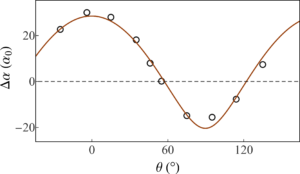
We characterized the anisotropic differential AC Stark shift for the Dy 626 nm narrow line transition, induced in a far-detuned 1070 nm optical dipole trap, and observed the existence of a “magic polarization” for which the polarizabilities of the ground and excited states are equal. From our measurements we extracted both the scalar and tensorial components of the dynamic dipole polarizability for the excited state, αse=179(5)α0 and αte=35(2)α0, respectively, where α0 is the atomic unit for the electric polarizability. Furthermore, we utilized our findings to optimize the efficiency of Doppler cooling of a trapped gas, by controlling the sign and magnitude of the inhomogeneous broadening of the optical transition.
Chalopin, T., Makhalov, V., Bouazza, C., Evrard, A., Barker, A., Lepers, M., Wyart, J.-F., Dulieu, O., Dalibard, J., Lopes, R., & Nascimbene, S., Anisotropic light shift and magic polarization of the intercombination line of dysprosium atoms in a far-detuned dipole trap, Phys. Rev. A 98, 040502 (2018).
Quantum-enhanced sensing using non-classical spin states of a highly magnetic atom
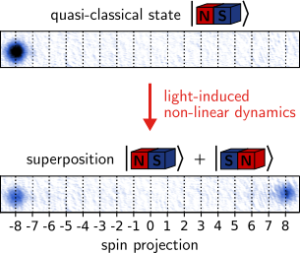
Coherent superposition states of a mesoscopic quantum object play a major role in our understanding of the quantum to classical boundary, as well as in quantum-enhanced metrology and computing. However, their practical realization and manipulation remains challenging, requiring a high degree of control of the system and its coupling to the environment. We used dysprosium atoms – the most magnetic element in its ground state – to realize coherent superpositions between electronic spin states of opposite orientation, with a mesoscopic spin size J=8. We drove coherent spin states to quantum superpositions using non-linear light-spin interactions, observing a series of collapses and revivals of quantum coherence. These states feature highly non-classical behavior, with a sensitivity to magnetic fields enhanced by a factor 13.9(1.1) compared to coherent spin states – close to the Heisenberg limit 2J=16 – and an intrinsic fragility to environmental noise.
Chalopin, T., Bouazza, C., Evrard, A., Makhalov, V., Dreon, D., Dalibard, J., Sidorenkov, L. A., & Nascimbene, S., Quantum-enhanced sensing using non-classical spin states of a highly magnetic atom, Nature Commun. 9, 4955 (2018).
Magneto-optical trapping of Lanthanide atoms on a narrow optical transition
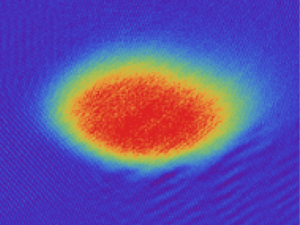
We studied the magneto-optical trapping of Dysprosium atoms on a narrow optical transition. The Dysprosium atoms are laser cooled using the optical transition at 626 nm, whose small linewidth of about 100 kHz leads to a Doppler temperature of 3.3 microK. As the radiative forces are relatively weak, gravity plays a crucial role and may lead to a complete polarization of the atomic spin. In this regime, we trap up to several hundred million atoms at a temperature of 10 microK. We also investigated the influence of light-induced molecular dynamics, which leads to atom loss and additional heating.
Dreon, D., Sidorenkov, L. A., Bouazza, C., Maineult, W., Dalibard, J., & Nascimbene, S., Optical cooling and trapping of highly magnetic atoms: the benefits of a spontaneous spin polarization. J. Phys. B 50, 065005 (2017).